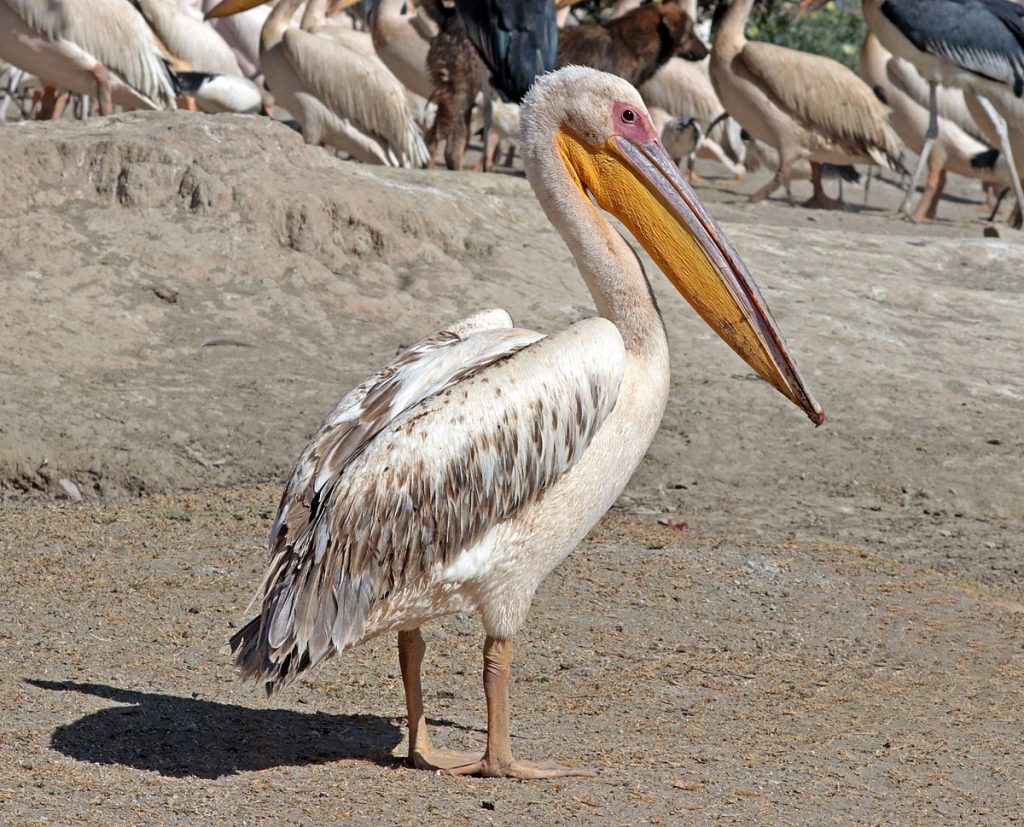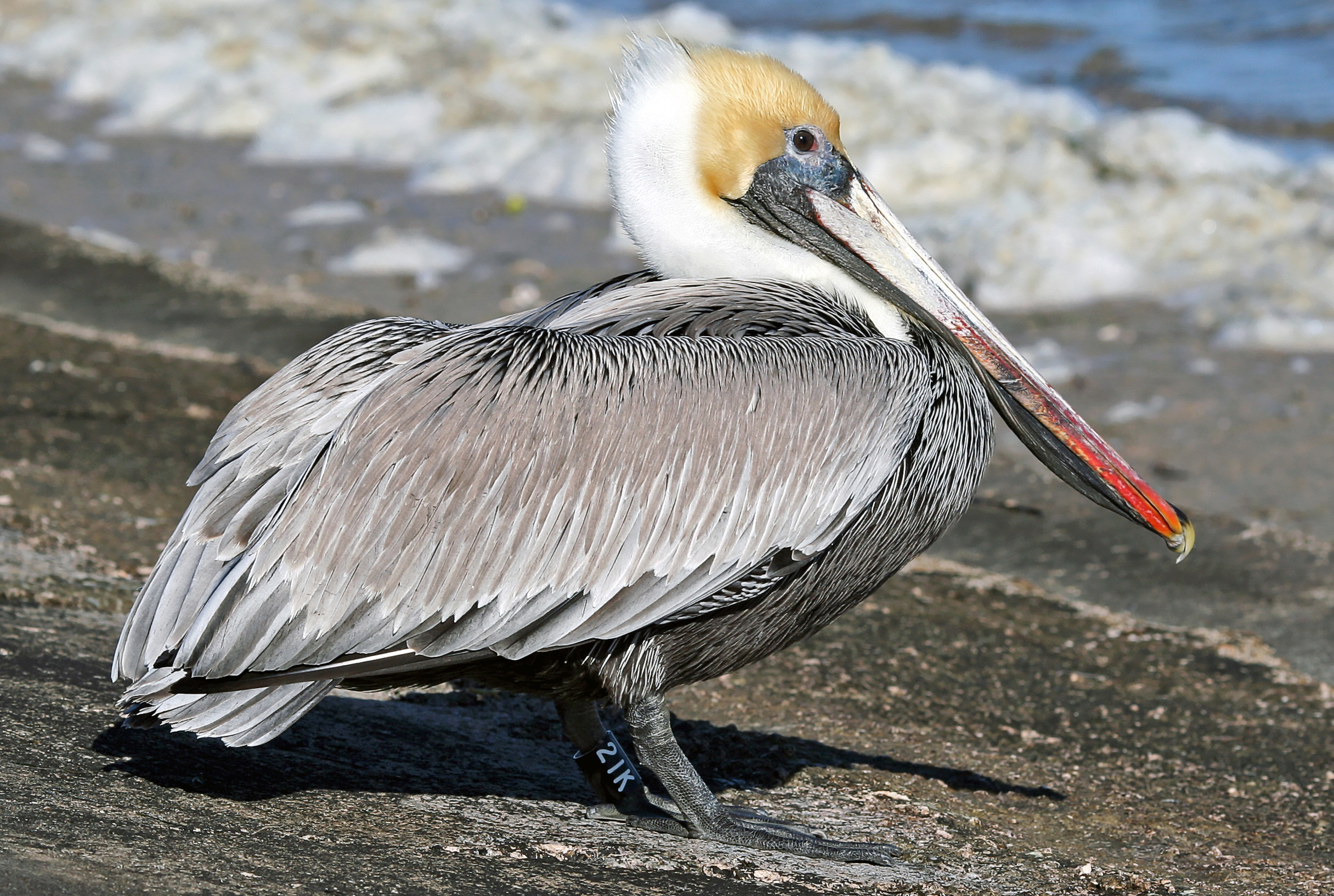In North America, you can come across two different types of Pelicans, both of which can be observed in Kansas. These species are the American White Pelican and the Brown Pelican.
Throughout the year, you can spot American White Pelicans in Kansas. Conversely, Brown Pelicans are not commonly found in this state and are rarely sighted.
Pelicans are among the largest birds in the world and are easily recognizable due to their massive bills, throat pouches, and feet. Despite their size, they possess lightness, aided by air pockets in their skeleton and skin, enabling them to float effortlessly. Their extensive wings assist them in graceful soaring during flight.
There exist a total of eight pelican species worldwide, with two inhabiting North America. These are the American White Pelican and Brown Pelicans.
During the breeding season, pelicans undergo distinct changes in their facial skin, throats, and bills, displaying more vibrant colors. Some even develop additional features on their bills.
Pelicans tend to breed in colonies, with up to 50,000 birds congregating together. Depending on the species, they may choose either ground or tree nesting. After approximately 25 days in the nest, the young pelicans gather in groups called “creches,” comprising up to 100 individuals. Remarkably, the parents can identify their own offspring and exclusively provide them with food.
While pelicans do consume other animals, they are not classified as birds of prey, as this designation is reserved for raptors. Their primary diet consists of fish, although they also consume crabs, frogs, snakes, mammals, birds, and insects.
To catch fish, pelicans employ their throat pouches, which they use to scoop up their prey and drain the water before swallowing. Young pelicans may directly feed from their parents’ pouches.
To aid in identifying the Pelican species found in Kansas, this guide utilizes information from bird watchers on ebird and data collected from avibase. It offers genuine insights into when these birds can be observed.
Pelicans Spotted in Kansas: 2 Species
American White Pelican

The American White Pelican is a year-round resident of Kansas, but their population increases during the migration periods from March to April and August to November. According to bird watchers’ checklists submitted for the state, they are recorded in 3% of summer and winter observations and up to 11% during migration.
American White Pelicans are majestic birds with an impressively wide wingspan, ranking as the second-largest among all North American birds.
Non-breeding adult American White Pelicans exhibit an all-white appearance, except for their black flight feathers visible during flight or when their wings are spread. They possess bluish-gray eyes and yellow facial skin encircling their eyes. Their bills, pouches, and feet display a pale orange hue. Juveniles have light gray feathers with darker brown napes.
Breeding adult American White Pelicans showcase distinct coloration compared to non-breeding adults. They develop a yellow plate on their upper bills, resembling a horn. Their bodies remain all-white, but their eyes, bills, legs, and feet become brighter shades of orange.
American White Pelicans undergo several molting changes known as “eclipse.” During spring, they exhibit a visible yellowish patch on their breast and chest, while in summer, blackish feathers emerge on their heads.
- Pelecanus erythrorhynchos
- Length: 60 – 63 in (152 – 160 cm)
- Weight: 246.4 oz (6983 g)
- Wingspan: 96 – 110 in (244 – 279 cm)
American White Pelicans breed in remote inland lakes of North America and spend their winters along the southern Pacific Coast of the US, the Gulf of
Mexico, Mexico, and Central America. During migration, they can be observed in various western and central US states.
These pelicans primarily inhabit shallow freshwater lakes, wetlands, and the perimeters of lakes and rivers. In winter, they can be found in coastal bays, inlets, and estuaries, where they forage in shallow waters and rest on sandbars.
Their diet primarily consists of fish. American White Pelicans swim on the water’s surface, capturing their prey with their enormous bills. They also engage in group foraging, cooperating strategically with other birds to drive fish toward the shore, where they can efficiently scoop them up.
American White Pelicans are opportunistic feeders, and they will travel long distances to find optimal feeding grounds. They may also consume crayfish, amphibians, salamanders, and are known to snatch fish from the water’s surface, stealing from other birds.
Regarding vocalizations, American White Pelicans are generally silent, emitting only a few grunts. However, their young can be quite noisy in large colonies, clamoring for food.
Their nests are simple, shallow depressions on the ground. Twigs, sticks, reeds, and other materials are added on top of the soil to provide protection for the eggs.
The female pelican lays one to two eggs, which both parents incubate for up to thirty-six days. Unfortunately, due to siblicide (when one sibling kills the other), only one chick survives per nest.
Fun Fact: The long bill of the American White Pelican possesses the remarkable capacity to hold three gallons of water. When scooping fish from the sea, the pelican tilts its bill downward, allowing the water to drain out, leaving only the fish inside its throat sac for consumption.
Brown Pelican

Brown Pelicans are not frequently sighted in Kansas, but there have been a couple of summer sightings. The last recorded sighting occurred near Cedar Bluff Reservoir in 2022.
Non-breeding adult Brown Pelicans typically feature white heads and necks with pale yellow foreheads. Their long bills display a combination of yellow and orange hues. Their bodies have a grayish-brown tone, accompanied by short black legs and webbed feet. Juveniles possess brown heads, necks, backs, and wings, with bluish-gray bills. Their undersides are light brown.
The Brown Pelican consists of five subspecies, with two of them breeding in the United States. P.o.californicus represents the Pacific Coast variant, while P.o.carolinensis is associated with the Atlantic Coast variant.
During the breeding season, the differences between Pacific and Atlantic Brown Pelicans become more apparent. Both species possess white heads with brighter yellow foreheads. The napes of their necks transition from white to dark brown. Atlantic Brown Pelicans have olive-brown throat pouches, while Pacific Brown Pelicans exhibit red skin on their throat pouches.
- Pelecanus occidentalis
- Length: 48 – 50 in (122 – 127 cm)
- Weight: 131.2 oz (3718 g)
- Wingspan: 78 – 84 in (198 – 213 cm)
Brown Pelicans either breed, migrate, or remain resident along the Pacific and Atlantic Coasts of North America, extending to northern South America.
These pelicans inhabit shallow water environments. They reside year-round in estuaries and coastal marine habitats. Additionally, they can be found on mangrove islets, sandbars, breakwaters, and offshore rocks while resting.
Brown Pelicans possess a unique foraging ability that sets them apart. They can dive into deep ocean waters, capturing their prey within their throat pouches. Upon resurfacing, the water drains from their pouches, allowing them to immediately swallow their catch.
Their primary diet consists of fish, such as sardines and herring. When not diving, they casually swim and seize prey with their bills. They may also consume crustaceans, amphibians, eggs, and other young birds.
As for vocalizations, adult Brown Pelicans are typically silent, aside from occasional grunts. However, juveniles tend to squawk in their begging calls for food.
Brown Pelicans construct nests more frequently on the ground rather than in trees. They usually conceal and protect their nests on islands, mangroves, and cliffs. The female builds the nest using reeds, leaves, pebbles, sticks, and soil. They lay two to four eggs, which both parents incubate for approximately a month.
Fun Fact: Brown Pelicans incubate their eggs by covering them with their webbed feet. However, this behavior became detrimental to their survival when the pesticide DDT led to the thinning of their eggshells, causing them to break under the weight of their parent’s feet. Extensive conservation efforts were required to restore the Brown Pelican population.
